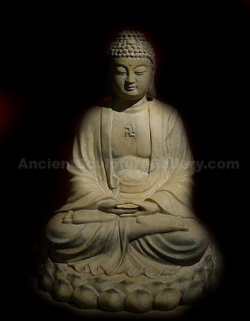Difference between revisions of "The Historical Buddha"
m (Text replacement - "to arrive at" to "to arrive at") |
|||
| Line 1: | Line 1: | ||
[[File:2952.jpg|thumb|250px|]] | [[File:2952.jpg|thumb|250px|]] | ||
| − | [[Buddhism]] was founded by [[Siddharta Gautama]], a {{Wiki|prince}} of the Shakya familiy that reigned over a small kingdom in modern [[Nepal]]. His epithet [[Shakyamuni]] (chin.: Shijiamouni 釋迦牟尼) means "[[Wise]] of the Shakya", other epitets are arhata "Thoroughly {{Wiki|saint}}" and [[tathagata]] "[[Thus]] Come One" (chin.: Rulai 如來). He was born in the [[Lumbini]] grove during the 6th century BC and was kept free from [[knowledge]] of daily [[suffering]] in the palace. During a ride he first became aware of [[human]] [[suffering]] in [[shape]] of an sick [[person]], an old man and a [[funeral]]. Very upset by these visions of true [[life]], [[Siddharta]] left his family and for seven years lived as an [[ascetic]], only to find out that the extreme [[ascetic]] [[life]] was not able to solve from [[suffering]]. He further relied upon [[meditation]] ([[dhyana]], chin.: [[chan]] 禪) to arrive at the {{Wiki|conclusions}} that made him a [[Buddha]] ("[[Enlightened]] Man", chin.: fo 佛 or Zhengjue 正覺), after [[being]] tempted by the [[evils]] of the [[world]] sent by the [[hell]] [[spirit]] [[Mara]] or [[Yama]] (chin.: mo 魔, yemo 夜摩), under a fig [[tree]] ("[[Bodhi tree]]", chin.: putishu [[菩提樹]]). In Isipattna/Benares, the [[Enlightened]] began to teach his sermons, the "[[Wheel]] of [[Teaching]]" ([[dharmacakra]], chin.: falun 法輪; a [[wheel]] is the [[symbol]] of [[Buddhism]], sometimes stylized as [[svastika]] 卍, chin.: wan), in Kusinara [[Buddha]] [[died]] and entered the [[nirvana]] ("[[extinction]]", chin.: ji 寂), free from the [[misery]] of [[karma]] (intended [[deeds]] and their accumulated results, the [[eternal]] [[rebirth]]; chin.: yinguo 因果) and the rotation of the [[world]] ([[samsara]], chin.: zhuanlun 轉輪). The stories of his [[life]] and [[enlightenment]] (chin.: wu 悟, jap.: [[satori]]) are accounted in the [[jataka tales]] (chin.: fo zhuan gushi 佛傳故事; especially [[birth]] stories, chin.: shousheng 受生). Among his close [[disciples]] was the famous [[Ananda]] (chin.: Anantuo 阿難陀). | + | [[Buddhism]] was founded by [[Siddharta Gautama]], a {{Wiki|prince}} of the [[Shakya]] familiy that reigned over a small {{Wiki|kingdom}} in {{Wiki|modern}} [[Nepal]]. His [[epithet]] [[Shakyamuni]] (chin.: Shijiamouni 釋迦牟尼) means "[[Wise]] of the [[Shakya]]", other epitets are arhata "Thoroughly {{Wiki|saint}}" and [[tathagata]] "[[Thus]] Come One" (chin.: Rulai 如來). He was born in the [[Lumbini]] grove during the 6th century BC and was kept free from [[knowledge]] of daily [[suffering]] in the palace. During a ride he first became aware of [[human]] [[suffering]] in [[shape]] of an sick [[person]], an old man and a [[funeral]]. Very upset by these visions of true [[life]], [[Siddharta]] left his family and for seven years lived as an [[ascetic]], only to find out that the extreme [[ascetic]] [[life]] was not able to solve from [[suffering]]. He further relied upon [[meditation]] ([[dhyana]], chin.: [[chan]] 禪) to arrive at the {{Wiki|conclusions}} that made him a [[Buddha]] ("[[Enlightened]] Man", chin.: fo 佛 or Zhengjue 正覺), after [[being]] tempted by the [[evils]] of the [[world]] sent by the [[hell]] [[spirit]] [[Mara]] or [[Yama]] (chin.: mo 魔, yemo 夜摩), under a fig [[tree]] ("[[Bodhi tree]]", chin.: putishu [[菩提樹]]). In Isipattna/Benares, the [[Enlightened]] began to teach his sermons, the "[[Wheel]] of [[Teaching]]" ([[dharmacakra]], chin.: falun 法輪; a [[wheel]] is the [[symbol]] of [[Buddhism]], sometimes stylized as [[svastika]] 卍, chin.: wan), in [[Kusinara]] [[Buddha]] [[died]] and entered the [[nirvana]] ("[[extinction]]", chin.: ji 寂), free from the [[misery]] of [[karma]] (intended [[deeds]] and their accumulated results, the [[eternal]] [[rebirth]]; chin.: yinguo 因果) and the rotation of the [[world]] ([[samsara]], chin.: zhuanlun 轉輪). The stories of his [[life]] and [[enlightenment]] (chin.: wu 悟, jap.: [[satori]]) are accounted in the [[jataka tales]] (chin.: fo zhuan gushi 佛傳故事; especially [[birth]] stories, chin.: shousheng 受生). Among his close [[disciples]] was the famous [[Ananda]] (chin.: Anantuo 阿難陀). |
{{R}} | {{R}} | ||
[http://www.chinaknowledge.de/Literature/Religion/buddhism.html www.chinaknowledge.de] | [http://www.chinaknowledge.de/Literature/Religion/buddhism.html www.chinaknowledge.de] | ||
Latest revision as of 12:16, 17 September 2013
Buddhism was founded by Siddharta Gautama, a prince of the Shakya familiy that reigned over a small kingdom in modern Nepal. His epithet Shakyamuni (chin.: Shijiamouni 釋迦牟尼) means "Wise of the Shakya", other epitets are arhata "Thoroughly saint" and tathagata "Thus Come One" (chin.: Rulai 如來). He was born in the Lumbini grove during the 6th century BC and was kept free from knowledge of daily suffering in the palace. During a ride he first became aware of human suffering in shape of an sick person, an old man and a funeral. Very upset by these visions of true life, Siddharta left his family and for seven years lived as an ascetic, only to find out that the extreme ascetic life was not able to solve from suffering. He further relied upon meditation (dhyana, chin.: chan 禪) to arrive at the conclusions that made him a Buddha ("Enlightened Man", chin.: fo 佛 or Zhengjue 正覺), after being tempted by the evils of the world sent by the hell spirit Mara or Yama (chin.: mo 魔, yemo 夜摩), under a fig tree ("Bodhi tree", chin.: putishu 菩提樹). In Isipattna/Benares, the Enlightened began to teach his sermons, the "Wheel of Teaching" (dharmacakra, chin.: falun 法輪; a wheel is the symbol of Buddhism, sometimes stylized as svastika 卍, chin.: wan), in Kusinara Buddha died and entered the nirvana ("extinction", chin.: ji 寂), free from the misery of karma (intended deeds and their accumulated results, the eternal rebirth; chin.: yinguo 因果) and the rotation of the world (samsara, chin.: zhuanlun 轉輪). The stories of his life and enlightenment (chin.: wu 悟, jap.: satori) are accounted in the jataka tales (chin.: fo zhuan gushi 佛傳故事; especially birth stories, chin.: shousheng 受生). Among his close disciples was the famous Ananda (chin.: Anantuo 阿難陀).
